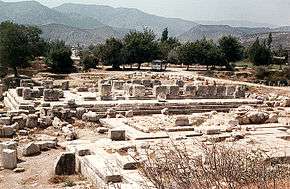Letoon trilingual

The Letoon trilingual is an inscription in three languages: standard Lycian or Lycian A, Greek and Aramaic covering the faces of a four-sided stone stele called the Letoon Trilingual Stele, discovered in 1973 during the archeological exploration of the Letoon temple complex, near Xanthos, ancient Lycia, in present-day Turkey. The inscription is a public record of a decree authorizing the establishment of a cult, with references to the deities, and provisions for officers in the new cult. The Lycian requires 41 lines; the Greek, 35 and the Aramaic, 27. They are not word-for-word translations, but each contains some information not present in the others. The Aramaic is somewhat condensed.[1]
Although the use of the term "Letoon" with regard to the inscription and the stele is unequivocal, there is no standard name for either. Xanthos trilingual is sometimes used, which is to be distinguished from the Xanthos bilingual, meaning the Xanthos stele. However, sometimes Xanthos stele is used of the Letoon trilingual stele as well as for the tomb at Xanthos. Moreover, the term Xanthos trilingual (Lycian A, Lycian B, Greek) is sometimes used of the tomb at Xanthos. In the latter two cases only the context can provide clues as to which stele is meant.
Find site
The Lētōon was a temple complex about 4 kilometres (2 mi) south of Xanthus, capital of ancient Lycia. The complex dates to as early as the 7th century BC and must have been a center for the Lycian League. In it were three temples to Lētō, Artemis and Apollō. The stele was found near the temple of Apollo. It has been removed to the museum at Fethiye. The entire site is currently under several inches of water.
Date of the inscription
The first five lines of the Aramaic version mention that the inscription was made in the first year of the reign of the Persian king, Artaxerxes, but does not say which Artaxerxes:
In the month siwan, year 1 of King Artaxerxes. In the frontier of Arñna. Pixodarus son of Katomno, the satrap who is in Karka and Termmila.[1]
If the king in question was Artaxerxes III Ochus, the date of the inscription is 358 BC. However, Pixodarus was satrap of Caria and Lycia no earlier than 341/340. Therefore the Persian king most likely was Arses, son of Artaxerxes III, who took his father's name on coming to power. In that case the trilingual is dated to 337/336 BC.[2]
Sample of the Lycian text
Below is a transliteration of a sample of lines and an interlineal English translation:[3]
| 1. | Ẽke: trm̃misñ: xssaθrapazate: pigesere: katamlah: tideimi: |
| When Pixodarus, the son of Hecatomnus, became satrap of Lycia, | |
| 2. | sẽñneñtepddẽhadẽ: trm̃mile: pddẽnehm̃mis: ijeru: senatrbbejẽmi: se(j)arñna: asaxlazu: erttimeli: |
| he appointed as rulers of Lycia Hieron (ijeru) and Apollodotos (natrbbejẽmi), and as governor (asaxlazu) of Xanthus, Artemelis (erttimeli). | |
| 3. | mehñtitubedẽ: arus: se(j)epewẽtlm̃mẽi: arñnãi: |
| The citizens (arus) and the Xanthian neighboring residents decided | |
| 4. | m̃maitẽ: kumezijẽ: θθẽ: xñtawati: xbidẽñni: se(j)arKKazuma: xñtawati: |
| to establish an altar to the Kaunian Ruler and the King Arkesimas | |
| 5. | sẽñnaitẽ: kumazu: mahãna: ebette: eseimiju: qñturahahñ: tideimi: |
| and they chose as priest Simias, the son of Kondorasis | |
| 6. | sede: eseimijaje: xuwatiti: |
| and whoever is closest to Simias | |
| 7. | seipijẽtẽ: arawã: |
| and they granted him exemption (arawã) | |
| 8. | ehbijẽ: esiti: |
| from taxes. | |
See also
References
Notes
Bibliography
- Bryce, Trevor R. (1986). The Lycians - Volume I: The Lycians in Literary and Epigraphic Sources. Copenhagen: Museum Tusculanum Press. ISBN 87-7289-023-1.
External links
- Melchert, Craig H. (2000). "The Trilingual Inscription of Letoon: Lycian Version" (pdf). Achemenet. Retrieved 2008-03-17.